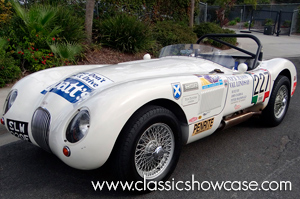1962 Jaguar C-Type Proteus Racer
Re-Creation
Specifications |
|
| Stock: | J62-370 |
| Current condition: | SHOW-DRIVER |
| Performance: | 3.4-litre twin-cam, straight-6 |
| Performance options: | Triple sidedraft Weber 45 DCOE carbs |
| Transmission: | 4 speed (with Overdrive) |
| Suspension: | Front: Independent, Rear: Live Axle |
| Color exterior: | White (with Racing decals) |
| Color interior: | Chrome/Black |
| Features: | Willans four-point harnesses, Willans four-point harnesses, removable roll bar |
| Mileage: | 12,396 showing |
| Wheels: | Chrome Wire Wheels |
| Tires: | Avon Turbo Steel 185/16 Radial Tires |
| Brakes: | Power Disc Brakes |
| Vin #: | 1J 50370 BW |
| Engine #: | 7J50524-8 |
| Gearbox #: | F61488 |

Description
(SOLD)
History
The Jaguar C-Type (officially called the Jaguar XK120-C) is a racing sports car built by Jaguar and sold from 1951 to 1953. The "C" stands for "competition". The car combined the running gear of the contemporary, road-proven XK120, with a lightweight tubular frame designed by Jaguar Chief Engineer William Heynes, and an aerodynamic aluminum body, jointly developed by William Heynes, R J (Bob) Knight and later Malcolm Sayer. A total of 53 C-Types were built, 43 of which were sold to private owners, mainly in the US. The road-going XK120’s 3.4-litre twin-cam, straight-6 engine produced between 160 and 180 bhp (134 kW). The C-Type version was originally tuned to around 205 bhp (153 kW). The early C-Types were fitted with SU carburetors and drum brakes. Later C-Types, produced from mid 1953, were more powerful, using triple twin-choke Weber carburetors and high-lift camshafts. They were also lighter, and braking performance was improved by using disc brakes on all four wheels. The lightweight, multi-tubular, triangulated frame was designed by Heynes. Heynes, Knight and Sayer together developed the aerodynamic body. Made of aluminum in the barchetta style, it was devoid of road-going items such as carpets, weather equipment and exterior door handles. According to the Jaguar Heritage Registry, the cars were produced between May 1952, starting with XKC001, and ending in August 1953 with XK054. The original alloy body was marked with the prefix K (e.g. K1037).
The C-Type was successful in racing, most notably at the Le Mans 24 hours race, which it won twice. In 1951, the car won at its first attempt. The factory entered three, whose driver pairings were Stirling Moss and Jack Fairman, Leslie Johnson and triple Mille Miglia winner Clemente Biondetti, and the eventual winners, Peter Walker and Peter Whitehead. The Walker-Whitehead car was the only factory entry to finish, the other two retiring with lack of oil pressure. A privately entered XK120, owned by Robert Lawrie, co-driven by Ivan Waller, also completed the race, finishing 11th.
